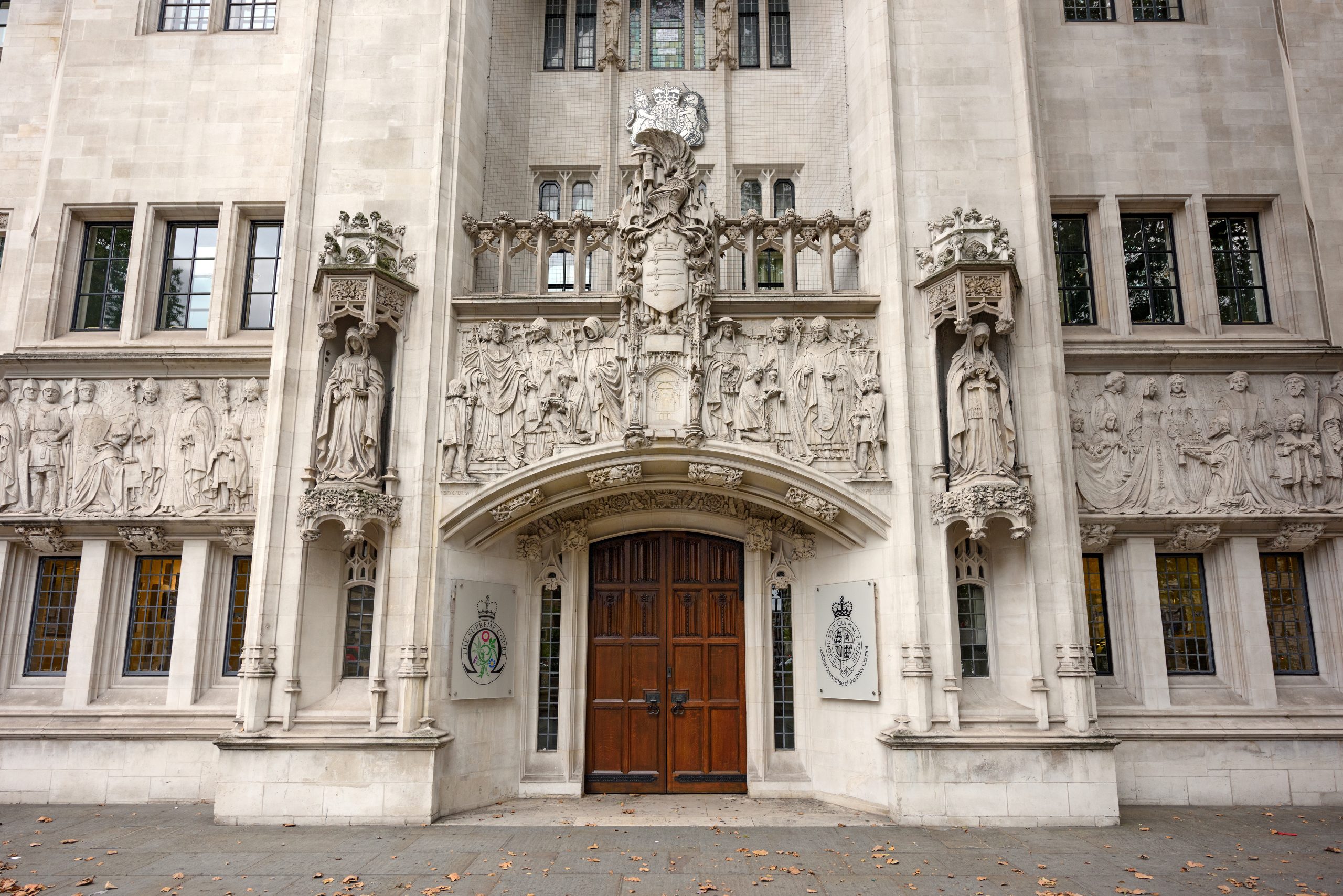‘Deliberate acts’ exclusion disapplied: Supreme Court decision on Public Liability
The Supreme Court has rejected attempts by an insurer to rely upon an exclusion clause under a public liability policy, in a case arising from the death of a customer following an assault by door staff at a bar in Aberdeen.
The security company’s insurance provided cover for accidental injury or death, but excluded "deliberate acts wilful neglect or default". The policy was governed by English law and there was no suggestion of any difference in approach under the law of this jurisdiction or Scotland in relation to the issues on appeal. The customer’s widow claimed against the insurer pursuant to the Third Party (Rights against Insurers) Act 2010, following liquidation of the security company employer, based on vicarious liability for wrongful acts of its employees.
The Supreme Court held that a “deliberate act” was something carried out with the intention of producing the insured outcome i.e. in this case, acts intended to cause injury. In reaching this conclusion, their Lordships recognised the commercial context of the policy to cover the business of “Manned Guarding and Door Security Contractors”, including unintended consequences of incidents at the bar door, which commonly involve deliberate physical acts. If every intentionally performed act was classed as deliberate for purposes of the exclusion, there would be no coverage for many accidental injuries the policy was designed to insure.
The same was true if “wilful neglect or default” was construed as extending the exclusion clause to acts embarked upon with reckless disregard for the consequences, in the sense of proceeding despite a known risk of injury, or not caring if such a risk may arise. Interpreting the exemption in that way would seriously limit the cover provided and lead to a “commercially unlikely exclusion, given the nature of the [insured]’s business”.
There was no determination in the earlier proceedings of intention to injure, or even recklessness, and it is not the role of appellate courts to make findings of fact. Following ejection from the bar due to intoxication, the customer hit out at security staff and was taken in a neck hold for up to three minutes, resulting in death from asphyxiation. In sentencing remarks, Lady Wolffe found that the employee’s actions were: “badly executed, not badly motivated … you believed you were acting in defence of your fellow door stewards and to minimise the danger you felt Mr Grant posed to others.”
The insurer was therefore unable to avoid liability. Following a series of pro-policyholder decisions, this appears to be another example of the Supreme Court’s willingness to take account of public policy considerations to avoid stripping insurance contracts of much of their content, and confirms that exclusion clauses will be construed based on the words used in their “documentary, factual and commercial context”, in accordance with principles set out in Wood v Capita Insurance Services Ltd [2017].
The decision is helpful for policyholders in demonstrating that conscious performance of an act with intention to cause insured damage must be established, in order to trigger a deliberate acts exclusion, and mere recklessness will not suffice. Whilst recklessness will be enough to prove breach of a reasonable precautions condition (Fraser v Furman [1967]), insurers face a higher evidential threshold in relation to ‘deliberate acts’.
Burnett or Grant v International Insurance Company of Hanover Ltd [2021] UKSC 12
https://www.supremecourt.uk/cases/docs/uksc-2019-0121-judgment.pdf
Amy Lacey is a partner at Fenchurch Law
The Good, the Bad & the Ugly: #13 (The Bad). Haberdashers’ Aske’s Federation Trust & v Lakehouse Contracts
Welcome to the latest in the series of blogs from Fenchurch Law: 100 cases every policyholder needs to know. An opinionated and practical guide to the most important insurance decisions relating to the London / English insurance markets, all looked at from a pro-policyholder perspective.
Some cases are correctly decided and positive for policyholders. We celebrate those cases as The Good.
Some cases are, in our view, bad for policyholders, wrongly decided, and in need of being overturned. We highlight those decisions as The Bad.
Other cases are bad for policyholders but seem (even to our policyholder-tinted eyes) to be correctly decided. Those cases can trip up even the most honest policyholder with the most genuine claim. We put the hazard lights on those cases as The Ugly.
At Fenchurch Law we love the insurance market. But we love policyholders just a little bit more.
#13 (The Bad)
Haberdashers’ Aske’s Federation Trust Ltd & others v (1) Lakehouse Contracts Ltd & (2) Cambridge Polymer Roofing Ltd [2018] EWHC 588 (TCC)
This case arose from fire damage to a school during construction works. The main contractor (“Lakehouse”) settled proceedings brought by the claimants for £8.75million, paid by the project insurers, and sought to recover £5million from its roofing sub-contractor (“CPR”), being the limit of indemnity under a separate CAR/liability policy taken out by CPR in accordance with express terms of the building contract.
The court was required to determine as a preliminary issue whether CPR was covered under the project policy, which included Lakehouse and its sub-contractors as insureds, and agreement of insurers by endorsement to “waive all rights of subrogation which they may have or acquire against any insured party”. The court held that CPR was not insured under the project policy, given the clear intention expressed in the sub-contract for CPR to take out and rely on its own insurance cover.
In reaching this conclusion, the Judge considered competing theories as to how a sub-contractor may obtain the benefit of project insurance, i.e. (1) the main insured acting as agent, with its conduct subsequently ratified by the sub-contractor (this was considered problematic as sub-contractors would not necessarily have been ascertained at the time of policy inception, nor be able to ratify if they had no insurable interest as yet); (2) a “standing offer” by project insurers to provide cover for members of a defined group; or (3) acceptance by the sub-contractor’s conduct that it would become an insured under the project policy. The standing offer rationale was considered to be the most appropriate.
An appeal was listed in January 2019 but the case settled before the hearing. Given a number of difficulties with the first instance decision, it is unfortunate that the opportunity for further debate and clarification in the Court of Appeal was missed on this occasion.
The Haberdashers judgment seems unfair in terms of a windfall for project insurers, who receive premium based on cover for sub-contractors of any tier, despite sub-contracts likely imposing additional insurance obligations. It is impossible for insurers to accurately rate their exposure on this basis, without knowing at the time of writing the project policy what limits a future (as yet unidentified) sub-contractor may or may not take out.
It seems odd that terms of a contract between third parties should determine who is insured under a pre-existing project policy. The decision effectively confines the scope of project insurers’ standing offer to provision of cover for “sub-contractors who have not agreed to obtain their own insurance” but such a limitation was nowhere to be found in the terms of the project policy.
Given the express waiver of subrogation rights, the reasoning seems inconsistent with the Supreme Court majority view in Gard Marine - that a strong presumption applies in favour of an implied term precluding claims between co-insureds (even if the contract contains an express warranty from the defendant to protect insured property); and the effect of co-insurance is to exclude - as opposed to discharge - liability as between co-insureds. On this reasoning Lakehouse would have no liability to the claimants, which suggests that there is no basis on which a back-to-back claim could be pursued against CPR.
The subrogated claim against CPR was limited to £5million and the Judge suggested (obiter) that project insurers would not have been able to recover the full loss, i.e. the additional £3.75million settlement sum, as it was surely not anticipated that CPR would bear any additional uninsured loss where there was project insurance in place with a higher limit. This was not fully explained in the judgment and begs the question of whether a hybrid situation could arise whereby a sub-contractor is not co-insured up to the limit of its own separate cover, but in excess of that level, becomes insured by the project policy. Further peculiarities as to apportionment of liability could arise where a mismatch occurs between the scope of cover under a project policy and the sub-contractor’s liability insurance, giving rise to significant uncertainties for policyholders and insurers alike.
In our view, the decision in Haberdashers is a bad one. We prefer the approach adopted by the Court of Appeal in Rathbone Brothers v Novae, to the effect that an overlapping insurance situation may arise, even where one policy was specifically intended to cover the loss in question.
Debate as to whether, and in what circumstances, primacy should be given to express allocation of risk within a construction contract as opposed to inferences drawn from the existence of a project policy is likely to continue. Even if a contractor is presumed to fall within the definition of insured parties under a project policy, it should ensure that risk allocation and insurance provisions in its construction contract(s) are consistent, for example by specifying that any separate insurance required to be taken out by the contractor should operate in excess of the project cover, to minimise the prospect of subrogated claims.
Amy Lacey is a partner at Fenchurch Law.
The Good, the Bad & the Ugly: 100 cases every policyholder needs to know. #12 (The Ugly). Tesco Stores Ltd v Constable & Ors
Welcome to the latest in the series of blogs from Fenchurch Law: 100 cases every policyholder needs to know. An opinionated and practical guide to the most important insurance decisions relating to the London / English insurance markets, all looked at from a pro-policyholder perspective.
Some cases are correctly decided and positive for policyholders. We celebrate those cases as The Good.
Some cases are, in our view, bad for policyholders, wrongly decided, and in need of being overturned. We highlight those decisions as The Bad.
Other cases are bad for policyholders but seem (even to our policyholder-tinted eyes) to be correctly decided. Those cases can trip up even the most honest policyholder with the most genuine claim. We put the hazard lights on those cases as The Ugly.
At Fenchurch Law we love the insurance market. But we love policyholders just a little bit more.
#12 (The Ugly)
Tesco Stores Ltd v Constable & Ors [2008] EWCA Civ 362
The case considered the scope of the cover provided by a “contractual liability” extension in a third party liability (“TPL”) policy (“the Policy”).
The claim by Tesco against its TPL insurers arose out of the collapse of a railway tunnel which had been built for Tesco in order to accommodate the construction of a new supermarket on top. The railway line was owned by Network Rail, but the trains were operated by Chiltern Railways (“Chiltern”). Luckily no one was injured by the collapse, but the track owned by Network Rail was damaged. No property owned by Chiltern was damaged, but as a result of the damage to the track it suffered a significant loss of profits due to the interruption of its services.
Tesco had entered into a Deed of Covenant (the “Deed”) with Chiltern, under which Tesco agreed to indemnity Chiltern for losses caused by the construction work for the new supermarket, including loss of profits. Following the collapse Chiltern made a substantial claim against Tesco under the Deed for its lost profits. Tesco, in turn, sought indemnity for its liability to Chiltern under its TPL policy.
Ordinarily, TPL policies cover policyholders for claims in tort by third parties, and are triggered by damage to or interference with property, or by bodily injury. TPL policies don’t ordinarily cover contractual claims, or claims for pure economic loss. The insuring clause in the Policy was in standard terms, and provided that:
“The insurer will indemnify [Tesco] against all sums for which [Tesco] shall be liable at law for damages in respect of:
- Death of or bodily injury to or illness or disease of any person;
- loss of damage to material property;
- obstruction, loss of amenities, trespass, nuisance or any like cause.”
However, the Policy also contained the following extension, headed “Contractual Liability”, which said that the Policy would cover “liability under a contract or agreement…which would not have attached in the absence of such contract” (“the Extension”).
On its face the Extension appeared to significantly increase the scope of the cover provided by the Policy. As Chiltern’s claim against Tesco was a contractual claim which wouldn’t have attached in the absence of the Deed, Tesco (not entirely unreasonably) assumed the Extension meant that the Policy would cover Tesco’s liability to Chiltern. Tesco’s TPL insurers disagreed, and the point was ultimately determined by the Court of Appeal.
The Court of Appeal made clear that the Extension was not a separate insuring clause, and that in order for the Extension to apply it was necessary for Tesco to demonstrate that the claim for which it sought indemnity fell within the insuring clause of the Policy in the first place. Whilst the Court of Appeal was satisfied that the phrase “liable at law for damages” in the insuring clause was sufficiently wide to encompass contractual claims, unfortunately for Tesco the Court took the view that the remainder of the insuring clause made clear that the Policy was intended to respond only to the types of liability that would ordinarily be covered by a TPL policy because: (i) each of the types of loss referred to in the sub-paragraphs of the insuring clause would all give rise to ordinary tort claims; and (ii) the causation phrase “in respect of” meant “for”, rather than something looser such as “in connection with” so that the loss covered by the Policy had to have been directly caused by one of those standard tort types of loss, and not just be more loosely connected to it.
It was not, therefore, sufficient that Chiltern’s loss of profits was related to damage to someone else (Network Rail)’s property. The Court of Appeal decided that the Extension did no more than provide cover for contractual liabilities which were co-extensive with Tesco’s tortious liabilities. As Tesco had no tortious liability to third parties (such as Chiltern) for loss of profits, the Policy therefore didn’t respond.
We can’t criticise the reasoning of the Court of Appeal in Tesco, and we don’t suggest that the case was wrongly decided. However, the decision is problematic for policyholders for two reasons. Firstly, from a policyholder’s point of view the Extension doesn’t “do what it says on the tin”, and it would not be obvious to a policyholder that a contractual liability extension needs to be read carefully alongside a different clause in the policy altogether in order for its meaning to be understood. Secondly, when combined with standard TPL insuring clauses, contractual liability extensions don’t actually provide much additional benefit, so that the apparent benefit is in reality something of an illusion.
However, the Court of Appeal’s reasoning does point to two potential “fixes” to the problem, from the policyholder’s perspective, in both cases by amending the insuring clause. The first fix is to include in the list of the types of loss covered by the Policy something other than losses that would result from ordinary tort claims. That may seem too radical an approach for a TPL policy (although wordings do exist which take approach), and so an approach that may be easier for policyholders to achieve would be to replace the phrase “in respect of” in the insuring clause with something something looser, like “in connection with”, or “in any way related to”. That would allow TPL policies to give full effect to contractual liability extensions, so that they cover contractual liabilities which are connected to property damage (and so not entirely unrelated to what a TPL policy is intended to do), but which aren’t directly caused by property damage. Had Tesco’s policy been drafted in that way, the contractual liability extension would then have covered Tesco’s liability for Chiltern’s loss of profits claim.
Authors
Rob Goodship, Senior Associate
Toby Nabarro, Associate
Webinar - Traps for Contractors and their Brokers
Practical issues to be aware of for those dealing with CAR and Contract Works policies, including the correct trigger for damage, when a defect may constitute damage and an overview of the two leading suites of defect exclusion clauses.
Rob Goodship is a Senior Associate at Fenchurch Law
You have to be pulling my LEG(3)
An unwelcome consequence of the London Market’s preference for including arbitration clauses in most types of commercial insurance policies, is that disputes regarding the meaning of clauses in those policies are frequently resolved in private, rather than in a public forum where the decision of a Court could assist policyholders and insurers in avoiding similar disputes in the future.
In a Construction All Risks context, insurers’ preference for arbitration clauses has had the remarkable effect that in the nearly 25 years since the London Engineering Group (“LEG”) first introduced its suite of defects exclusions, there has not been a single Court decision, anywhere in the world, on the meaning of the defects exclusion which LEG intended to be the most favourable for policyholders: LEG3.
So, if there are no reported cases on LEG3 then where can one look for guidance? The current (2nd) edition of Paul Reed QC’s excellent book “Construction All Risks” doesn’t consider LEG3 in any detail. Whilst we understand that the omission will be corrected in the forthcoming 3rd edition, at present Mr Reed’s book refers to LEG3 as being an equivalent of the most favourable of the “DE” defects exclusions: DE5. That equivalence, however, is not accepted in all parts of the insurance market.
As noted in an article published by Iftikhar Ali of DWF in 2019, the absence of the word “additional” from LEG3 (as opposed to DE5, which explicitly excludes “additional costs of improvement”) has encouraged some to interpret LEG3 as excluding all costs which relate to works which have the effect of improving the original works. If this interpretation was correct then it would produce particularly harsh results for policyholders where the contract works have suffered damage as a result of defects in design, as in one sense all remedial works carried out according to a different design must necessarily be an improvement if the remedial works are defect-free as a result. For that reason Mr Ali (correctly in our view) reaches the view that such an interpretation, whilst consistent with a literal reading of LEG3, would be “a commercial nonsense”. Unfortunately, in our experience, that does not always prevent insurers from running the argument, to the surprise and disappointment of any policyholder or broker who is familiar with how the market ordinarily approaches the clause.
Whilst other texts and commentaries are consistent with the guidance notes produced by the London Engineering Group itself, that LEG3 was intended by the underwriters who drafted it to provide the “the widest form of cover, for physical damage caused by defects”, none of the texts or commentaries discuss how, precisely, one should determine: (i) what constitutes an improvement for the purposes of LEG3; and (ii) what cost is thereby excluded. This article attempts to address that gap.
What is an improvement for the purposes of LEG3?
For the purposes of this article the relevant part of LEG3 provides that:
“the cost of replacement or rectification which is hereby excluded is that cost incurred to improve the original material workmanship design plan or specification” (our emphasis).
It seems to us that for remedial works to constitute an improvement as compared with the original works:
- The remedial works must be different in some way from the original works; and
- That difference must be more than an equally valid way of performing the works, and must produce a tangible benefit (for instance an improved factor of safety, or a longer design life, or superior functionality - in all cases as compared with the original works as completed, as opposed to the outcome desired by the employer).
The requirement for the difference to produce a tangible benefit in order to constitute an “improvement” is important. The fact that remedial works are different to the original works does not on its own mean that they are an improvement, even if the remedial works are more expensive.
In the context of a Construction All Risks claim, if an insurer cannot identify a tangible benefit produced by the remedial works as compared with the original works, then it will not be able to show that the remedial works are an improvement, and any difference in cost between the remedial works and the original works will be irrelevant, and should not result in a deduction under LEG3. It is only if the insurer is able to identify a tangible benefit produced by a way in which the remedial works are different from the original works that one is required to consider what cost is thereby excluded by LEG3.
What cost is excluded?
Once one has a taken a view not just on how the remedial works are different from the original works, but also in what way that difference relates to a tangible benefit (i.e. what is the “improvement”), one can then try to identify the cost that relates to that improvement. Pausing there, it is of course entirely possible that there may be no “cost” of improvement, because a policyholder may find a different way of approaching the remedial works which, although producing a tangible benefit as compared with the original works, is nevertheless cheaper than the original works. In that situation whilst there is an “improvement”, there would be no “cost incurred to improve”, but rather a saving.
Any other interpretation would be precisely the “commercial nonsense” referred to by Mr Ali, and we doubt that there is a single CAR underwriter who, when writing a risk, would want to encourage their policyholder to carry out remedial works more expensively than a cheaper and better alternative if one was available.
Assuming, then, that remedial works are both an improvement, and are more expensive than the original works, it seems to us that the “cost incurred to improve” can then be identified in one of the two following ways.
Item by item comparisons
Depending on the facts, it may be possible to identify excluded costs on an item by item basis. For instance, there will be occasions when:
- Some elements of the remedial works are different to the original works, but produce no tangible benefit (“Differences”);
- Some elements of the remedial works are exactly the same as the original works; and
- Some elements of the remedial works are different to the original works, and do produce a tangible benefit (“Improvements”).
In that situation, the Differences may occasionally be cheaper than the comparable items of the original works. However, there wouldn’t be any justification, in our view, for offsetting any such savings against the cost of the Improvements if those were more expensive than comparable items of the original works. Rather, the cost excluded by LEG3 in that situation would be the un-discounted difference in cost between the Improvements, and the comparable items of the original works.
Equally, if the Differences are more expensive than the comparable items of the original works we can see no justification for excluding the difference in cost relating to them: what is excluded by LEG3 remains the difference in cost between the Improvements, and the comparable items of the original works.
It should be obvious, we hope, that any differences in cost which relate to elements of the remedial works which are exactly the same as the original works, are unaffected by LEG3.
The approach of separating Differences and Improvements should, in our view, be applied not only to separate items of work, but where required by the facts can also be used to identify the excluded costs where individual items of work may contain both Differences and Improvements.
Items of work containing both Differences and Improvements
How this would work in practice in relation to individual items of work can be illustrated by considering a length of steel pipe which was under-specified, has suffered damage by becoming deformed under expected pressure, and has been replaced by thicker steel pipe. In that situation:
- There is a difference between the original works and the remedial works, in that a thicker steel pipe has been used in the remedial works; and
- The fact that the steel pipe used in the remedial works is thicker than that used in the original works produces a tangible benefit, in that is more robust and less likely to become deformed under expected pressure (i.e. the pipework constitutes an Improvement in that it is thicker).
Suppose the thicker steel pipe used in the remedial works is more expensive for two reasons:
- Because more steel has been used to make it thicker; and
- Because the cost of steel has increased since the original works were carried out.
In that situation LEG3 would only exclude the cost of making the pipe thicker by using more steel, as it is only that cost which is related to the way in which the thicker steel pipe is superior to the original steel pipe. The increased material cost is not related to the way in which the thicker steel pipe is superior to the original steel pipe, and so that difference in cost is not, in our view, excluded by LEG3.
Holistic comparisons
There will be other occasions where individual items of remedial work cannot sensibly be compared with any items of the original works (for instance, where the remedial works follow a substantially re-designed scheme). In that situation it will be necessary to compare the overall (remedial and original) schemes with each other.
Even in that situation, however, care needs to be taken not simply to subtract the cost of the original works from the cost of the remedial works in order to identify the cost excluded by LEG3, because that would risk including Differences (i.e. which don’t relate to the way in which the remedial works improve the original works). Rather, the cost of any Differences (e.g. fluctuations in material costs), need to be identified and disregarded.
Ordinarily the most appropriate way to do so in order to produce a reliable holistic comparison, is to compare the cost of the remedial works against not the cost of the original works, but against the cost that would have been incurred if the original works had been re-performed (in exactly the same way) following the occurrence of damage instead of the remedial works which were actually done.
Authors:
Rob Goodship, Associate Partner
Government to fund replacement of non-ACM cladding systems on residential buildings
On 11 March, the government announced that it would provide up to £1 billion in 2020/21 to fund the removal and replacement of unsafe non-ACM cladding systems on high-rise residential buildings.
Attitudes towards building safety have undergone a paradigm shift since the tragic events at Grenfell Tower. Since then, the government has introduced a wide-ranging package of measures to ensure that buildings, particularly those with Aluminum Composite (ACM) cladding, are made safe. Notably, the government last year introduced a fund of £600m for the replacement of unsafe ACM cladding from residential buildings, similar to the type that was in place on Grenfell Tower.
Although ACM cladding remains the government’s priority, it has now announced proposals to extend funding for the removal and replacement of non-ACM cladding, such as High Pressure Laminate panels (‘HPL’). The announcement follows the guidance issued by the government earlier in the year in its “Consolidated Advice Note on Building Safety”, and in particular, the views of its Expert Panel that HPL systems with a ‘C’ or ‘D’ (i.e. those with a medium or high contribution to fire) would not meet the requirements of the Building Regulations, and that owners of such buildings should replace those materials as soon as possible.
Funding will be available to both the social and private sectors. In the private sector, the fund will be for the benefit of leaseholders to ensure that their buildings are made safe; and in the social sector, where remediation costs would otherwise be too prohibitive.
What are the eligibility criteria?
As with the ACM fund last year, funding will be available for buildings that are 18m or above.
The government has also said that building owners will be required to pursue warranty claims and take “appropriate action against those responsible for putting unsafe cladding on these buildings, with any damages recovered paid to Government once recouped.”
What are warranty claims?
Warranty claims refer to claims made under latent defect insurance policies. Those policies provide cover for newly built properties in the event of an inherent defect that was not capable of being discovered through inspection before completion.
Typically, latent defect policies are triggered in the event of (a) a non-compliance with the relevant Building Regulations that applied at the time of construction/conversion; and (b) which causes a present or imminent danger.
Given the above, unsafe non-ACM cladding that has been installed in high-rise residential blocks is likely to meet those requirements.
What other claims might be available against those responsible for putting unsafe cladding on buildings?
Those involved with the original cladding installations may include Main Contractors, Architects, and specialist cladding subcontractors. The type of claims that can be brought against them will differ in each case, and will depend upon the nature of the relationships between the parties, and the specific work that was undertaken.
One route to making a recovery against those involved with the original cladding installation is under the Defective Premises Act 1972.
The Defective Premises Act imposes a duty on builders and any other professionals who take on work in connection with the provision of a dwelling. It requires the work to be done in a professional or workmanlike manner, with proper materials, and that the dwelling is for habitation when completed. The duty is owed to every person who acquires a legal or equitable interest in the dwelling.
Summary
The announcement of funding for the remediation of non-ACM buildings underlines the government’s ever-increasing commitment to building safety.
It is also likely to come as a blow to latent defect insurers, who may face a surge in the number of claims made under their policies. The potential for claims will be increased if, as expected, local authorities and Fire and Rescue Services are granted enforcement powers where building owners refuse to apply for funding, or otherwise refuse to remediate their buildings.
Alex Rosenfield is a Senior associate at Fenchurch Law
Building a Safer Future: Regulatory Reform on Combustible Cladding
Following publication of the Hackitt Report in May 2018, the government has been under increasing pressure to implement effective reform of building regulations in the UK, with a focus on cladding systems to high-rise developments. Legislation has recently been introduced aimed at improving fire safety and accountability, with a range of further measures anticipated.
Building (Amendment) Regulations 2018
Regulations came into force on 21 December banning the use of combustible materials in external walls of buildings above 18 metres in height, including residential dwellings, boarding schools, student accommodation, registered care homes and hospitals (SI 2018/1230). The new rules also apply where building work is a "material change of use" that brings an existing building within one of these categories. Commercial buildings, including hotels and offices, are excluded.
The ban does not apply retrospectively to existing structures, including where a building notice or initial notice has been given to, or full plans deposited with, a local authority before the legislation commencement date, provided that building work has already started or starts within two months thereafter.
The press release announcing the ban confirms the government's "full backing" for local authorities to enable them to carry out emergency work on private residential buildings with unsafe cladding, including financial assistance, although local authorities will be expected to recover the costs from building owners. This is not mentioned in the Regulations and seems to indicate support for councils in using their existing powers relating to unsafe buildings, pursuant to the Building Act 1984.
Approved Documents 7 (Materials & Workmanship) and B (Fire Safety)
Regulation 7 of the Building Regulations 2010 requires that materials used in building work are appropriate for the circumstances. A new sub-section 7(2) has been introduced, directing that all materials which become part of an external wall, including “specified attachments” such as balconies and solar panels, achieve European fire safety classification (A2-s1, d0) or (A1), meaning only limited combustibility or non-combustible materials will be permitted. Certain limited components are exempted by regulation 7(3), including gaskets, sealants, windows and any part of a roof.
Approved Document B has been updated to include additional guidance at paragraph 12.6 that insulation products and filler materials used in external walls in buildings of 18 metres or more “should be of limited combustibility or better”. It is no longer permissible therefore to incorporate combustible materials within masonry or concrete walls to new high-rise buildings, such as the Reynobond polyethylene core ACM panels that were used on Grenfell Tower.
Further changes to Approved Document B come into effect on 21 January 2019, clarifying the role of assessments in lieu of testing for cladding and fire safety systems. In accordance with Hackitt recommendations, use of desktop studies should be restricted to appropriate situations backed up with sufficient test evidence, with those undertaking assessments able to demonstrate suitable competence.
The government has launched a wider call for evidence to gather views on (1) more extensive changes to Approved Document B technical requirements, and (2) how residents and landlords can work together to keep their homes and buildings safe. A new Standards Committee is being established to advise on applicable rules, together with a Joint Regulators’ Group to trial proposed legislative changes.
Prescriptive Requirements
The outcomes-based approach to building regulations in the UK puts the onus on companies to operate safely, allowing flexibility and seeking to ensure that emerging risks are addressed without the need for new legislation. However, problems have been highlighted around the lack of clarity in applicable rules, with insufficiently stringent oversight to avoid low standards and damaging conflicts of interest.
Changes to Approved Document B signify a departure from the level of discretion allowed under the previous regime, and moves towards a more prescriptive regulatory framework. The use of combustible materials has not been eliminated entirely though and many commentators believe the proposals do not go far enough. A stricter system of building control applies in some other jurisdictions such as France, Germany and North America, with significantly more emphasis on prescriptive baseline requirements to protect the life safety of building users.
Industry groups are lobbying for the 18 metres requirement to be reduced and the Scottish government has pledged a similar ban for buildings over 11 metres in height, including entertainment and assembly buildings. Related concerns around sprinklers, alarm systems and alternative means of escape in high-rise buildings merit urgent reconsideration as part of integrated reforms.
Future Developments
The second phase of the Grenfell Tower Inquiry is unlikely to start until the end of 2019, according to its chairman Sir Martin Moore-Bick, with some 200,000 documents (including in relation to installation of the cladding and insulation) still to be disclosed. The first phase centred on the night of the incident, and the second will examine wider issues surrounding the fire.
Disputes over remediation of private blocks affected by potentially dangerous cladding materials are ongoing in many cases, exacerbated by complexities in proving clear breaches of applicable building regulations in order to establish liability. Stakeholders in affected properties should consider whether existing insurance, warranties or guarantees can meet the costs of cladding replacement, and seek appropriate advice from policyholder coverage specialists.
Amy Lacey is a partner at Fenchurch Law
The Good, the Bad & the Ugly: 100 cases every policyholder needs to know. #4 (The Good). The Orjula
Welcome to the latest in the series of blogs from Fenchurch Law: 100 cases every policyholder needs to know. An opinionated and practical guide to the most important insurance decisions relating to the London / English insurance markets, all looked at from a pro-policyholder perspective.
Some cases are correctly decided and positive for policyholders. We celebrate those cases as The Good.
Some cases are, in our view, bad for policyholders, wrongly decided, and in need of being overturned. We highlight those decisions as The Bad.
Other cases are bad for policyholders but seem (even to our policyholder-tinted eyes) to be correctly decided. Those are cases that can trip up even the most honest policyholder with the most genuine claim. We put the hazard lights on those cases as The Ugly.
At Fenchurch Law we love the insurance market. But we love policyholders just a little bit more.
#4 (The Good)
Losinjska Plovidba v Transco Overseas Ltd (The Orjula) 14 June 1995
In a useful decision for policyholders under construction all risks insurance, the Commercial Court in The Orjula determined that the spillage of hydrochloric acid onto a vessel requiring decontamination was “damage”, even on the assumption that there was no corrosion. Although decided in the context of a negligence claim, the case opened up the possibility of greater recoveries under policies triggered by damage, demonstrating that even transient or reversible physical changes to insured property should suffice.
The decision
The claimant was a bareboat charterer of a vessel which operated a liner service. Two containers each containing 72 drums of acid were loaded on to the vessel in England, for transportation to Libya. The second defendant, whose application to strike out the claimant’s claim was being determined by the Court, was the physical supplier of the drums to the first defendant, the named shipper in the Bill of Lading.
On its route to Libya the vessel docked in Holland, where one of the containers was discovered to be leaking. On inspection it was found that the drums inside were damaged and required replacement and reloading, with the boat having to be decontaminated and the drums repacked inside the containers.
The Court, in refusing to strike out the claim against the second defendant, held that although it was only necessary to wash the acid off the boat before it could again be in a useable condition, a specialist cleaner had to be employed for this purpose before the vessel could again set sail. As a result, the claimant had suffered actual damage, not pure economic loss (which would not have been recoverable from the second defendant in negligence[1]).
The second defendant’s solicitor argued that there was no physical damage to the vessel. The contamination could be and was cleaned off with a soda solution and the only loss was the financial cost of the operation. The Judge summed up the defence argument as being, in effect, that prior to the cleaning the vessel remained undamaged albeit with a layer of hydrochloric acid over part of her deck or hatch.
Taking guidance from civil and criminal authorities, the Court considered whether there had been “injury impairing value or usefulness” of the property in question, and the need for effort and expense to restore the property to its former usable condition. The Judge rejected the submission that there was no damage, noting:
“Here, specialist contractors were engaged in undertaking the decontamination work using soda to neutralise the acid before washing the deck and hatch covers down with fresh water; further, it is pleaded, perhaps not surprisingly, that the vessel was required to be decontaminated of the hydrochloric acid before she could sail from the special berth to which she had been directed after discovery of the leakage. On these alleged facts, I would have no hesitation in concluding that the vessel should be regarded as having suffered damage by reason of her contamination”.
The alleged contamination of the vessel was held to constitute damage sufficient to enable the claimant to claim in tort against the second defendant for recovery of its loss and mitigation costs arising from negligence in the stowage of the containers.
Comment
In determining that damage was suffered in these circumstances, the Court acknowledged the reality that “injury impairing value or usefulness” (the dictionary definition of damage) can be sustained without there having been a permanent change to the damaged material.
The question of whether damage has occurred is often contentious in CAR insurance claims and this case is helpful in support of improved outcomes for policyholders, subject to expert evidence in appropriate cases and applicable policy wording.
[1] Murphy v Brentwood District Council [1991] 1 AG 398








